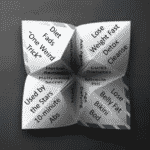A guide to this series:
Part 1 covers planning and budgeting – campaign goals and budget, campaign timeline, list selection
Parts 2 & 3 cover development of the direct mail piece – the offer, form factor, headline, and price plus persuasive copy and design.
Part 4 covers follow-on marketing and evaluation of campaign results.
For most postcards and self-mailers, less is more when it comes to content and design.
You don’t have a lot of real estate to play with. You’ve got to catch the reader’s interest in a couple of seconds AND motivate them to respond.
So every word and image has to overachieve, which is why direct mail generally isn’t a smart do-it-yourself project.
Here’s a checklist that will help you grade your marketing pieces, whether you have an in-house marketing team, an outside agency – or do it all yourself.
15-Point Checklist: Grade Your Wellness Marketing Materials
And some additional do’s and don’ts:
Do:
- Make your company’s message and value proposition clear in every mailing.
- Spread your mailings for the last year flat on a table. Is there a unifying thread?
- Differentiate your business. Have you ever noticed how many wellness businesses say the same things in their marketing and ads?
- Start with an attention-grabbing headline focused on a problem or opportunity your potential customer would love to solve
- Do highlight and explain actual benefits for customers
- Back up your claims with evidence. Many, many health and wellness businesses make claims but don’t offer convincing evidence that they can deliver.
- Use the magic words: free and you. Free brochure, free sample, free report, free assessment, free analysis, free consultation, free demonstration, free trial.
- Use photos. Pictures grab attention. Text-only mailings usually don’t.
- Use pix of real customers and real staff. Informal, relaxed, and candid, not posed and Photoshopped.
Don’t:
- Overhype your service with trite superlatives and overblown and exaggerated claims
- Treat copy as an afterthought or DIY project. It’s hard work that requires gathering tons of information about your service and customers – and then picking and choosing the most important bits and finding the very best way to communicate them.
- Blather about who you are, your business philosophy and history, and the objectives of your firm. Your potential client just wants to know, “What’s in it for me? How will my life be better?”
- Use first-person pronouns: “We us, our, I, me.” Talk to your customer about your customer with second-person pronouns instead: “you” and “your”.
A quick test: count the number of times your copy uses your company name or first-person pronouns. Compare that total to the number of times your copy uses “you” or “your”. Was your copy written for you – or your potential customer?!
- Over-rely on graphics. Graphics and photos are just part of the package – your content does the heavy lifting
- Use implausibly flawless stock images of perfect people who look nothing like your target customer
- Fall for what we call “showcase designs” that rely on oversized images and special graphic effects with minimal text. Looks artistic, but won’t work as a marketing piece.




